How to make Sourdough Starter Powder
Sourdough Starter Powder! Introducing a whole new way to store and use sourdough starter or sourdough discard. Dry it, then grind it to a powder.
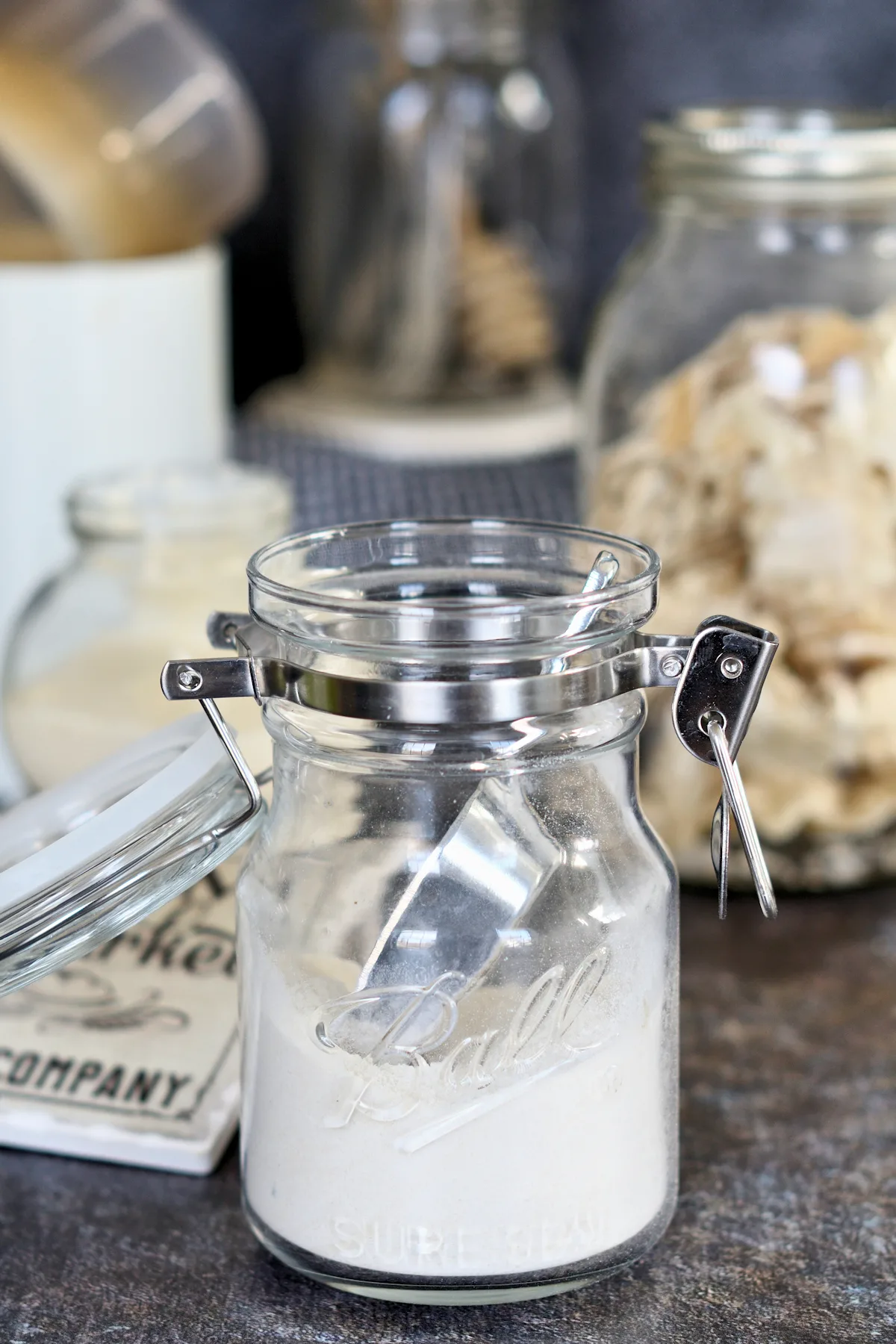
So you’ve jumped on the sourdough bandwagon, YAY! It’s so much fun, isn’t it?
But there are times when real life interferes and you may not be able to bake your favorite sourdough bread recipe for quite a while. Or maybe you want to share your starter with a friend who lives far away. Or maybe you just really hate to discard that discard.
The solution is an incredibly easy-to-do process for drying your starter. Once the starter is completely dried, your hard-won wild yeast goes dormant. The dried starter chips can then be stored indefinitely. But wait, there’s more….
Turn your dried sourdough discard into a powder!
After you dry your sourdough starter, you can grind it into a powder. Why pulverize dried sourdough? First of all, it takes up less storage space and powdered starter will rehydrate a little more quickly. But there’s an even better reason for grinding sourdough starter.
You can add sourdough powder directly to a recipe for a big flavor boost without adding any extra water to the recipe. This opens up a whole new world of sourdough recipes.
I’ve developed many recipes that use sourdough discard. Wet sourdough discard is pretty easy to incorporate into a recipe. Sourdough discard can replace a portion of the flour and water in almost any recipe. The water in the original recipe could be in the form of actual water, or the water can come from milk, buttermilk, egg whites, etc.
But what can we do when there is no or very little water in the original recipe? I had to ask myself that question when I was trying to create a recipe for Sourdough Shortbread.
Shortbread dough couldn’t be simpler with just 4 ingredients; butter, sugar, flour and salt. The only trace of water in that recipe comes from the butter, and flour needs water to develop gluten.
The “short” in shortbread refers to the fact that without much water the dough cannot develop long gluten strands. Less developed gluten means your cookie will have a tender and crumbly texture.
When I tried adding sourdough discard to my shortbread dough the cookies were chewy and not at all crumbly. The discard added too much water to the dough. The water developed the gluten, yada, yada, yada, tough cookies.
LIGHTBULB: I had to figure out how to add sourdough discard to a recipe without adding any water. It took quite a few trials but I finally did it. I made a sourdough powder that could be added directly to the dough.
Tips for using Sourdough Powder directly in a recipe:
- I tried grinding the sourdough chips in a food processor and the powder was not fine enough. You need to use spice grinder to get a fine, flour-like powder.
- After grinding, sift the powder though a very fine sieve. Then grind the rough bits again and sift. Continue until all the starter is finely ground. The texture should be no coarser than cornmeal or the final product will be gritty.
- Drying a slightly active starter makes a lighter chip because it will bubble a bit as it dries. Lighter chips grind more easily. But you can definitely make sourdough powder from a very ripe discard. Just keep grinding and sifting.
- Store the sourdough powder in a tightly covered container away from any moisture.
- The powder should keep at room temperature indefinitely.
You might also want to try these Sourdough Chocolate Chip Cookies made with sourdough powder.
If you find this information helpful, I’d really appreciate a 5-star review.
How to make Sourdough Starter Powder
Equipment
Instructions
- Weigh out 4 oz of dried sourdough starter chips and place them in the spice grinder. If you can't fit all the chips in at once you can grind them in batches.
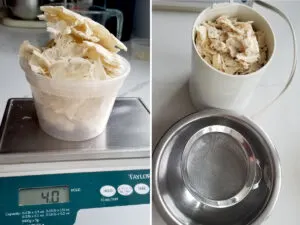
- Grind the chips to a powder. Sift the powder through a fine sieve to remove any large bits.
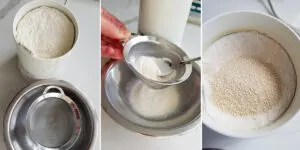
- Grind the sifted bits with any remaining chips until you have 4 oz of fine powder. The powder should be no coarser than semolina flour or cornmeal if you want to use it directly in a recipe. If you will be rehydrating the powder to use as a starter a coarser grind is fine.
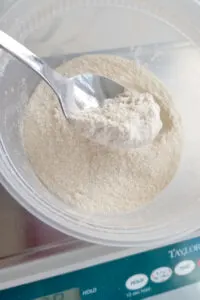
- Store the sourdough powder in a jar or plastic container with a tight fitting lid to keep out moisture.
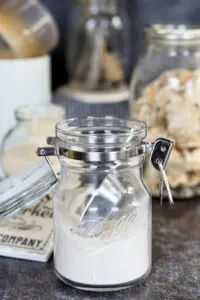

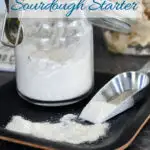
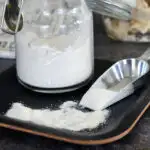
I have dried starter many times and this is the first time anyone has ever written about it! Thanks for getting it out to the world. I’m sure a lot of bakers will really appreciate it.
I really appreciate the info on drying & grinding sourdough starter. We are in the process of moving out of state & I didn’t want to start over. Now when I have an over abundance of sourdough I will dry it & grind for all the recipes you have shared. Thank you,
Wonderful! Good luck with the move.
I would like to make the chocolate cake. but dont have powder sourdough.. is there a substitute for the powder sourdough.
tia
This chocolate cake recipe doesn’t use sourdough powder, it uses sourdough discard.
Such a great article! Just what i was looking for! When you turn discard to powder does it still have all the health benefits without feeding it and turning it back into a starter?
I couldn’t say. I have no expertise regarding health benefits.
hi hi –
Thank you for the lovely guide!!
A question: is the powder acts like wild yeast? or more like flour? For instance, if you have a recipe that calls for some yeast, and I’m heading the powder, do I still need to add yeast?
Thank you!!
I’m using the powder mostly as a flavoring, as I did in my Sourdough Shortbread Cookies. You can’t use it as a yeast since the yeast in the dried starter is dormant. You can rehydrate the powder back to an active starter.
How do you dry your sourdough starter? Do you use a silicon tray in a dehydrator?
If you read through the post regarding how to dry sourdough starter you’ll see photos and specific directions for oven drying, air drying and food dehydrator.
First, I am loving your sourdough recipes! I have made several breads, chocolate cake and oatmeal cookies, but the recipe my family loves the most is the sourdough rolls! They were a hit at both Thanksgiving and Christmas.
My question is about drying the starter. I tend to bake more with the discard and I was wondering how long you can starve a discard (stored in the fridge) before drying it? Or should it be fed within a week of drying?
Thank you for all your great tips and recipes!
If you read through the process for how to dry sourdough starter you’ll see that I used both a quite ripe discard (unfed for more than a week in the fridge) and a fairly active starter. Both worked well. The riper discard did need an extra feeding before it was active enough to use. As long as the starter is not dead you can try and dry it. Again, the less active it is the harder it will be to revive. But if you plan to use it as a powder to make the sourdough cookies, that’s not a problem.
As a trier and failer at sour dough bread, and killer of many good sour dough starters this has made my day! Now I will have another go…
I’m new to sourdough baking and any problems along the way are worth the ultimate end product – learning, flavor, texture, and shelf life.
This is a great article. I’ve already followed your instructions on drying starter into chips. I then vacuum seal the jar.
What I see here is a way to preserve a favorite starter as a backup for a possible catastrophic loss of the active stock or if going on an extended vacation where dragging along starter and food to maintain a culture is not practical or worse, by possibly being detained by TSA personnel for transporting a suspicious substance. That would be both funny and uncomfortable.
I also enjoyed your debunking legacy starters if not maintaining them using the same flour from the same region in which it was first incubated. After that, I made my own using rye and after only three weeks, it’s an active, bubbly and very flavorful starter.
I’m actually super-excited about the possibilities for this sourdough powder. I think the idea of using it directly as an ingredients is something completely new. I googled and searched and haven’t found anyone doing this. I’m drying more discard in my food dehydrator today for more recipe testing.
@Eileen Gray,
Oh, 5-Stars kid.
We’re going to get along just fine! I love the “why” more so than the “how.” Technique is super important as is getting to know how the flour you’re using behaves. I came from gluten-free baking, so a fairly long learning curve is not new to me.
I’ve not seen drying starter anywhere before either, but you can buy the powder regardless. Guess it WAS some sort of secret. Thanks again for your great site. I’m anxious to learn more from you and see your book. I’m not much for cookbooks because most end up collecting dust then taken to thrift stores or the dumpsters.